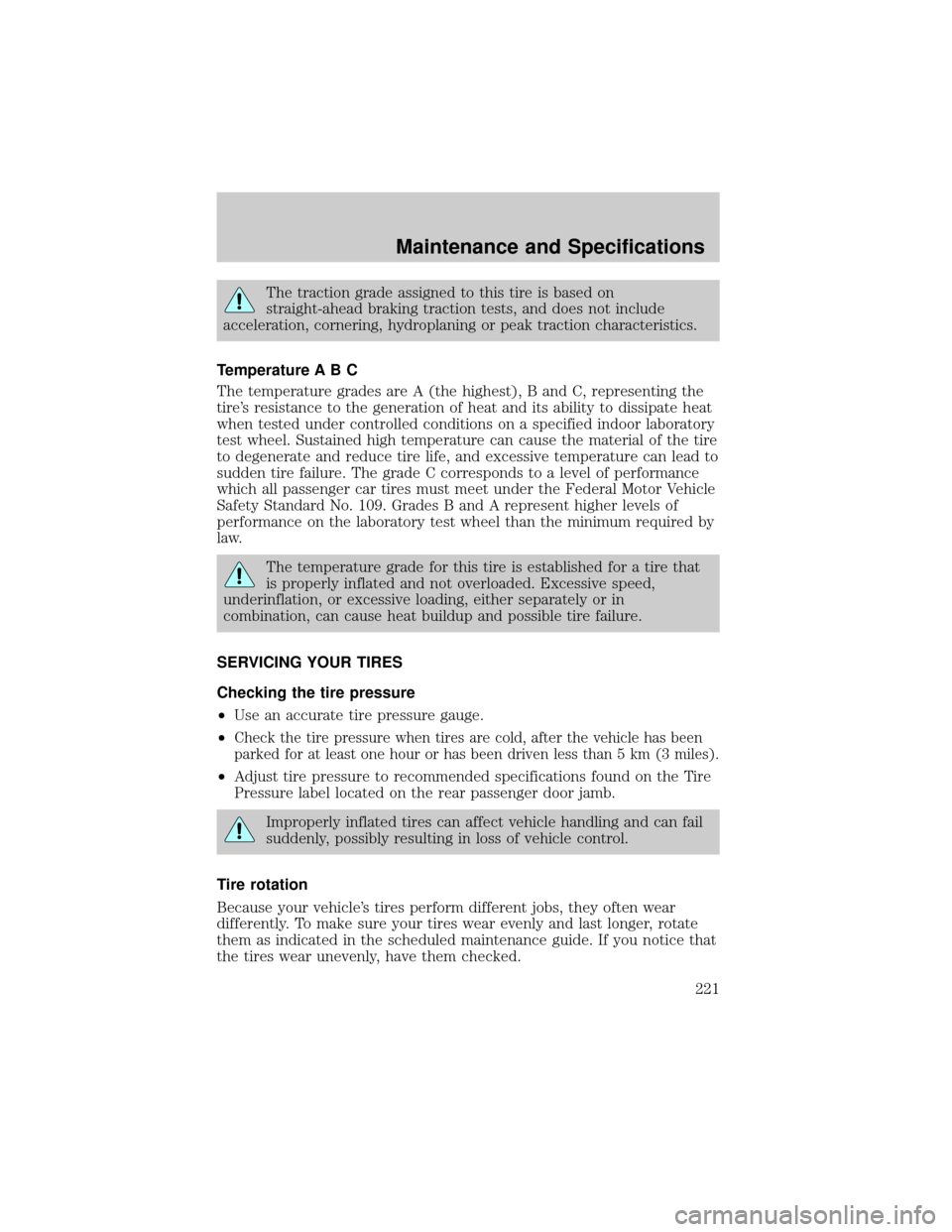Page 164 of 240

Fuse/Relay
LocationFuse Amp
RatingPower Distribution Box
Description
10 50A** See Fuses 1, 2, 6, 7, 10, 11, 13
and Circuit Breaker 14
11 50A** See Fuses 4, 8, 16 and Circuit
Breaker 12
12 30A** PCM Power Relay, PCM, Natural
Gas Vehicle Module
13 50A** High Speed Cooling Fan Relay
14 40A** Rear Window Defrost Relay, Also
see Fuse 17
15 40A** Anti-Lock Brake Module
16 50A** Police Option Fuse Holder
17 30A CB Cooling Fan Relay
Relay 1 Ð Rear Defrost Relay
Relay 2 Ð Horn Relay
Relay 3 Ð Cooling Fan Relay
Relay 4 Ð Air Suspension Pump Relay,
Police Power Relay
* Mini Fuses ** Maxi Fuses
Relays
Relays are located in the power distribution box and should be replaced
by qualified technicians.
CHANGING THE TIRES
If you get a flat tire while driving, do not apply the brake heavily.
Instead, gradually decrease your speed. Hold the steering wheel firmly
and slowly move to a safe place on the side of the road.
The use of tire sealants is not recommended and may compromise the
integrity of your tires. The use of tire sealants may also affect your tire
pressure monitoring system (if equipped).
Temporary spare tire information
Your vehicle may have a temporary or full-size spare tire. The temporary
spare tire for your vehicle is labeled as such. It is smaller than a regular
tire and is designed for emergency use only. Replace this tire with a
full-size tire as soon as possible.
Roadside Emergencies
164
Page 221 of 240

The traction grade assigned to this tire is based on
straight-ahead braking traction tests, and does not include
acceleration, cornering, hydroplaning or peak traction characteristics.
Temperature A B C
The temperature grades are A (the highest), B and C, representing the
tire's resistance to the generation of heat and its ability to dissipate heat
when tested under controlled conditions on a specified indoor laboratory
test wheel. Sustained high temperature can cause the material of the tire
to degenerate and reduce tire life, and excessive temperature can lead to
sudden tire failure. The grade C corresponds to a level of performance
which all passenger car tires must meet under the Federal Motor Vehicle
Safety Standard No. 109. Grades B and A represent higher levels of
performance on the laboratory test wheel than the minimum required by
law.
The temperature grade for this tire is established for a tire that
is properly inflated and not overloaded. Excessive speed,
underinflation, or excessive loading, either separately or in
combination, can cause heat buildup and possible tire failure.
SERVICING YOUR TIRES
Checking the tire pressure
²Use an accurate tire pressure gauge.
²
Check the tire pressure when tires are cold, after the vehicle has been
parked for at least one hour or has been driven less than 5 km (3 miles).
²Adjust tire pressure to recommended specifications found on the Tire
Pressure label located on the rear passenger door jamb.
Improperly inflated tires can affect vehicle handling and can fail
suddenly, possibly resulting in loss of vehicle control.
Tire rotation
Because your vehicle's tires perform different jobs, they often wear
differently. To make sure your tires wear evenly and last longer, rotate
them as indicated in the scheduled maintenance guide. If you notice that
the tires wear unevenly, have them checked.
Maintenance and Specifications
221
Page 238 of 240

cleaning the safety
belts .................................122, 189
extension assembly ................121
for adults .........................113±115
for children .............................127
lap belt ....................................116
Occupant Classification
Sensor ......................................110
warning light and
chime ...................13, 16, 117±118
Safety seats for children ..........130
Seat belts (see Safety
restraints) ..................................108
Seats ..........................................104
child safety seats ....................130
cleaning ...................................188
SecuriLock passive anti-theft
system ................................100±102
Servicing your vehicle ..............191
Spare tire (see Changing the
Tire) ...........................................164
Spark plugs,
specifications .....................224, 228
Specification chart,
lubricants ...........................226, 228
Speed control ..............................79
Speedometer ...............................20
Starting your vehicle ........137±139
jump starting ..........................169
Steering
speed sensitive .......................146
Steering wheel
controls ..........................73, 79, 83
tilting .........................................73T
Tires ...........................164, 220±221
changing ..........................164±165
checking the pressure ............221
replacing ..................................223
rotating ....................................221
snow tires and chains ............224
tire grades ...............................221
treadwear ................................220
Towing .......................................152
recreational towing .................155
trailer towing ..........................152
wrecker ....................................174
Traction control ........................144
active light ................................14
Traction-lok rear axle ...............150
Transmission .............................146
fluid, checking and adding
(automatic) .............................216
fluid, refill capacities ..............225
lubricant specifications ..226, 228
Trip odometer .............................21
Trunk ...........................................92
remote release ....................89, 95
Turn signal ............................15, 65
V
Vehicle dimensions ...................228
Vehicle Identification Number
(VIN) ..........................................230
Vehicle loading ..........................151
Ventilating your vehicle ...........141
Index
238